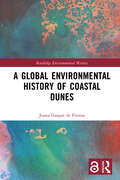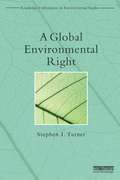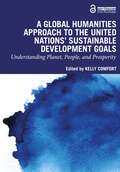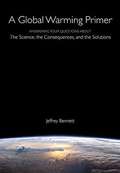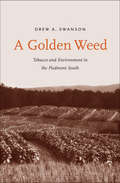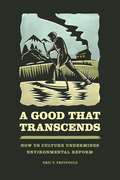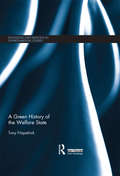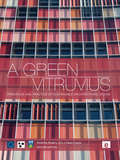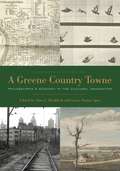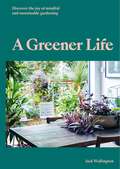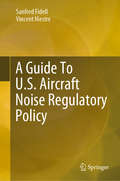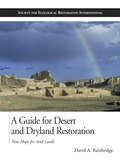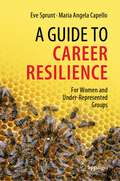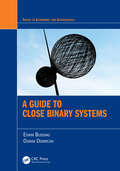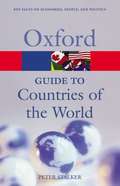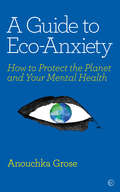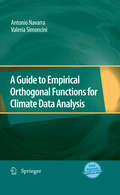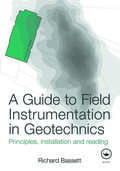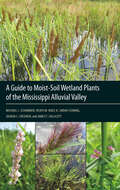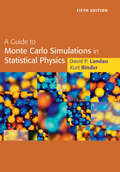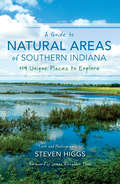- Table View
- List View
A Global Environmental History of Coastal Dunes (Routledge Environmental History)
by Joana Gaspar de FreitasThis book provides a holistic perspective on coastal dunes, highlighting new insights into present-day challenges to show that narratives, along with numbers, graphics, and computer models, have a role to play in climate change science, policymaking, and citizenship awareness.Adopting a cross-disciplinary approach, this book combines fiction, history, and science, to discuss past, present, and future ways of living in coastal areas. Dunes are hybrid environments, a combination of natural elements and human agency; they tell stories of values, traditional wisdom, institutions, empires, technology, vulnerabilities, coastal management, adaptation, andsustainability. Drawing on the past, Joana Gaspar de Freitas unpacks a diverse and fascinating history of dunes, linking knowledge, methods, and approaches from several case studies across the world, including France, Portugal, Brazil, Mozambique, New Zealand, USA, and the UK. The book connects the bio geophysics of global change with the main driver of transformation— human agency—to integrate and address nature-society issues, taking human and nonhuman agents into account. In following the choices, paths, and strategies that created today’s coastal landscapes, the book generates greater awareness and understanding of how to shape coastal futures.This is an engaging, original, and, fundamentally, important book that fills a gap in our knowledge of cities, infrastructure, economies, and cultures built on shorelines. A key read for scholars, researchers, and students in environmental history, environmental science, sustainability, coastal land management, and climate change.
A Global Environmental Right (Routledge Explorations in Environmental Studies)
by Stephen TurnerThe development of an international substantive environmental right on a global level has long been a contested issue. To a limited extent environmental rights have developed in a fragmented way through different legal regimes. This book examines the potential for the development of a global environmental right that would create legal duties for all types of decision-makers and provide the bedrock for a new system of international environmental governance. Taking a problem solving approach, the book seeks to demonstrate how straightforward and logical changes to the existing global legal architecture would address some of the fundamental root causes of environmental degradation. It puts forward a draft global environmental right that would integrate duties for both state and non-state actors within reformed systems of environmental governance and a rational framework for business and industry to adhere to in order that those systems could be made operational. It also examines the failures of the existing international climate change regime and explains how the draft global environmental right could remedy existing deficits. This innovative and interdisciplinary book will be of great interest to policy-makers, students and researchers in international environmental law, climate change, environmental politics and global environmental governance as well as those studying the WTO, international trade law, human rights law, constitutional law and corporate law.
A Global Humanities Approach to the United Nations' Sustainable Development Goals: Understanding Planet, People, and Prosperity
by Kelly ComfortThis edited textbook explores the 17 UN SDGs through 12 works from the humanities, including films, novels, and photographic collections. It provides students with the knowledge and understanding of how the humanities engage in broader social, political, economic, and environmental dialogue, offering a global perspective that crosses national and continental borders. The book takes students through the UN SDGs from a theoretical perspective through to practical applications, first through specific global humanities examples and then through students’ own final projects and reflections. Centered around three major themes of planet, people, and prosperity, the textbook encourages students to explore and apply the Goals using a place-based, culturally rooted approach while simultaneously acknowledging and understanding their global importance. The text’s examples range from documentary and feature film to photography and literature, including Wang Jiuliang’s Plastic China, Kip Andersen and Keegan Kuhn’s Cowspiracy: The Sustainability Secret, Barbara Dombrowski’s Tropic Ice: Dialog Between Places Affected by Climate Change, and Aravind Adiga’s The White Tiger, among others. Providing diverse geographic and cultural perspectives, the works take readers to Argentina, Australia, China, Costa Rica, Ecuador, France, Greenland, Haiti, India, Japan, Peru, Rwanda, Senegal, and the United States. This broad textbook can be used by students and instructors at undergraduate and postgraduate levels from any subject background, particularly, but not exclusively, those in the humanities. With added discussion questions, research assignments, writing prompts, and creative project ideas, students will gain a nuanced understanding of the interconnectivity between social, cultural, ethical, political, economic, and environmental factors.
A Global Warming Primer: Answering Your Questions About The Science, The Consequences, And The Solutions
by Jeffrey BennettIs human-induced global warming a real threat to our future? Most people will express an opinion on this question, but relatively few can back their opinions with solid evidence. Many times we've even heard pundits say "I am not a scientist" to avoid the issue altogether. But the truth is, the basic science is not that difficult. Using a question and answer format, this book will help readers achieve three major goals: To see that anyone can understand the basic science of global warming; To understand the arguments about this issue made by skeptics, so that readers will be able to decide for themselves what to believe; To understand why, despite the "gloom and doom" that often surrounds this topic, the solutions are ones that will not only protect the world for our children and grandchildren, but that will actually lead us to a stronger economy with energy that is cheaper, cleaner, and more abundant than the energy we use today.
A Golden Weed
by Dr Drew A. SwansonDrew A. Swanson has written an "environmental" history about a crop of great historical and economic significance: American tobacco. A preferred agricultural product for much of the South, the tobacco plant would ultimately degrade the land that nurtured it, but as the author provocatively argues, the choice of crop initially made perfect agrarian as well as financial sense for southern planters. Swanson, who brings to his narrative the experience of having grown up on a working Virginia tobacco farm, explores how one attempt at agricultural permanence went seriously awry. He weaves together social, agricultural, and cultural history of the Piedmont region and illustrates how ideas about race and landscape management became entangled under slavery and afterward. Challenging long-held perceptions, this innovative study examines not only the material relationships that connected crop, land, and people but also the justifications that encouraged tobacco farming in the region.
A Good That Transcends: How US Culture Undermines Environmental Reform
by Eric T. FreyfogleSince the birth of the modern environmental movement in the 1970s, the United States has witnessed dramatic shifts in social equality, ecological viewpoints, and environmental policy. With these changes has also come an increased popular resistance to environmental reform, but, as Eric T. Freyfogle reveals in this book, that resistance has far deeper roots. Calling upon key environmental voices from the past and present—including Aldo Leopold, Wendell Berry, David Orr, and even Pope Francis in his Encyclical—and exploring core concepts like wilderness and the tragedy of the commons, A Good That Transcends not only unearths the causes of our embedded culture of resistance, but also offers a path forward to true, lasting environmental initiatives. A lawyer by training, with expertise in property rights, Freyfogle uses his legal knowledge to demonstrate that bad land use practices are rooted in the way in which we see the natural world, value it, and understand our place within it. While social and economic factors are important components of our current predicament, it is our culture, he shows, that is driving the reform crisis—and in the face of accelerating environmental change, a change in culture is vital. Drawing upon a diverse array of disciplines from history and philosophy to the life sciences, economics, and literature, Freyfogle seeks better ways for humans to live in nature, helping us to rethink our relationship with the land and craft a new conservation ethic. By confronting our ongoing resistance to reform as well as pointing the way toward a common good, A Good That Transcends enables us to see how we might rise above institutional and cultural challenges, look at environmental problems, appreciate their severity, and both support and participate in reform.
A Green History of the Welfare State (Routledge Explorations in Environmental Studies)
by Tony FitzpatrickEnvironmental problems – particularly climate change – have become increasingly important to governments and social researchers in recent decades. Debates about their implications for social policies and welfare reforms are now moving towards centre stage. What has been missing from such debates is an account of the history of the welfare state in relation to environmental issues and green ideas. A Green History of the Welfare State fills this gap. How have the environmental and social policy agendas developed? To what extent have welfare systems been informed by the principles of environmental ethics and politics? How effective has the welfare state been at addressing environmental problems? How might the history of social policies be reimagined? With its lively, chronological narrative, this book provides answers to these questions. Through overviews of key periods, politicians and reforms the book weaves together a range of subjects into a new kind of historical tapestry, including: social policy, economics, party politics, government action and legislation, and environmental issues. This book will be a valuable resource for students and scholars of environmental policy and history, social and public policy, social history, sociology and politics.
A Green Vitruvius: Principles and Practice of Sustainable Architectural Design
by Vivienne Brophy J Owen Lewis2000 years ago the roman architect Marcus Vitruvius Pollio wrote the ten books on architecture establishing the concept of the pattern book offering design principles and solutions that is still referred to in every architect's education. A Green Vitruvius is intended as a green pattern book for today. Now fully updated, this well established textbook provides advice suitable for undergraduate and post graduate students on the integration of sustainable practice into the design and construction process, the issues to be considered, the strategies to be adopted, the elements of green design and design evaluation within the process. Classic design elegance is found in the holistic clear solution.
A Greene Country Towne: Philadelphia’s Ecology in the Cultural Imagination
by Alan C. Braddock Laura Turner IgoeAn unconventional history of Philadelphia that operates at the threshold of cultural and environmental studies, A Greene Country Towne expands the meaning of community beyond people to encompass nonhuman beings, things, and forces.By examining a diverse range of cultural acts and material objects created in Philadelphia—from Native American artifacts, early stoves, and literary works to public parks, photographs, and paintings—through the lens of new materialism, the essays in A Greene Country Towne ask us to consider an urban environmental history in which humans are not the only protagonists. This collection reimagines the city as a system of constantly evolving constituents and agencies that have interacted over time, a system powerfully captured by Philadelphia artists, writers, architects, and planners since the seventeenth century. In addition to the editors, contributors to this volume are Maria Farland, Nate Gabriel, Andrea L. M. Hansen, Scott Hicks, Michael Dean Mackintosh, Amy E. Menzer, Stephen Nepa, John Ott, Sue Ann Prince, and Mary I. Unger.
A Greene Country Towne: Philadelphia’s Ecology in the Cultural Imagination
by Alan C. Braddock Laura Turner IgoeAn unconventional history of Philadelphia that operates at the threshold of cultural and environmental studies, A Greene Country Towne expands the meaning of community beyond people to encompass nonhuman beings, things, and forces.By examining a diverse range of cultural acts and material objects created in Philadelphia—from Native American artifacts, early stoves, and literary works to public parks, photographs, and paintings—through the lens of new materialism, the essays in A Greene Country Towne ask us to consider an urban environmental history in which humans are not the only protagonists. This collection reimagines the city as a system of constantly evolving constituents and agencies that have interacted over time, a system powerfully captured by Philadelphia artists, writers, architects, and planners since the seventeenth century. In addition to the editors, contributors to this volume are Maria Farland, Nate Gabriel, Andrea L. M. Hansen, Scott Hicks, Michael Dean Mackintosh, Amy E. Menzer, Stephen Nepa, John Ott, Sue Ann Prince, and Mary I. Unger.
A Greener Life: Discover the joy of mindful and sustainable gardening
by Jack Wallington'This is a clearly presented work, with accessible topic headings and plenty of good advice sprinkled with engaging personal anecdotes. The message at the book's heart is to adopt a greener way of being and to see oneself as part of nature, not removed from it. On this point it is exceptional, distinguishing itself from many of the green gardening books written in recent years.' The English Garden magazine'Conversational, interesting, and personal ... it reaffirms the link between what we love to do and why we should be doing it with nature, the planet and our health in mind.' RHS The Garden magazineIf you want a sustainable garden and a better relationship with nature, A Greener Life is the guide you need. Packed with inspirational images and practical tips, the book covers garden planning, organic composting and vegetable growing, as well as sustainable planting, rewilding and wildlife-attracting environments. Learn traditional gardening techniques like propagating and growing from cuttings to make your garden self-sustaining, and discover plants that attract hover flies, bees and butterflies. With Jack Wallington's warmth and expertise on every page, this is an ideal book for new gardeners seeking greener practices.
A Greener Life: Discover the joy of mindful and sustainable gardening
by Jack Wallington'This is a clearly presented work, with accessible topic headings and plenty of good advice sprinkled with engaging personal anecdotes. The message at the book's heart is to adopt a greener way of being and to see oneself as part of nature, not removed from it. On this point it is exceptional, distinguishing itself from many of the green gardening books written in recent years.' The English Garden magazine'Conversational, interesting, and personal ... it reaffirms the link between what we love to do and why we should be doing it with nature, the planet and our health in mind.' RHS The Garden magazineIf you want a sustainable garden and a better relationship with nature, A Greener Life is the guide you need. Packed with inspirational images and practical tips, the book covers garden planning, organic composting and vegetable growing, as well as sustainable planting, rewilding and wildlife-attracting environments. Learn traditional gardening techniques like propagating and growing from cuttings to make your garden self-sustaining, and discover plants that attract hover flies, bees and butterflies. With Jack Wallington's warmth and expertise on every page, this is an ideal book for new gardeners seeking greener practices.
A Guide To U.S. Aircraft Noise Regulatory Policy (Springerbriefs In Applied Sciences And Technology Ser.)
by Sanford Fidell Vincent MestreAviation noise remains the primary hindrance to expansion of airport and airspace capacity in the United States. This book describes the development and practice of U.S. aircraft noise regulation, as well as the practical consequences of regulatory policy. Starting in the pre-jet transport era, the book traces the development of the modern framework for characterizing, standardizing, predicting, disclosing, and mitigating aircraft noise and its effects on airport-vicinity communities. Among other matters, the book treats noise-related consequences of the 1978 deregulation of the airline industry; prediction and mitigation of community reaction to airport noise; land use compatibility planning; recent research and industry trends; and some suggestions for potential improvements to current policy. Initial chapters describe the assumptions underlying aircraft noise regulation, and lay out the chronology of U.S. aircraft noise regulatory practice. Later chapters provide overviews of population-level effects of aviation noise, including health effects, speech and sleep interference, and annoyance. Readers will learn why predictions of the prevalence of aircraft noise-induced annoyance have systematically underestimated adverse community response to aircraft noise, and how such underestimation has complicated approval and funding of airport and airspace improvement projects. They will also learn why attempts at noise-compatible land use planning are seldom fully successful.
A Guide for Desert and Dryland Restoration: New Hope for Arid Lands (Science Practice Ecological Restoration)
by David A. BainbridgeDryland degradation and desertification now affect almost a billion people around the world. Tragically, the biological resources and productivity of millions of acres of land are lost to desertification each year because people remain unaware of strategies and techniques that could improve yields, reduce risk, and begin healing the world's deserts. A Guide for Desert and Dryland Restoration is the first book to offer practical, field-tested solutions to this critical problem. Author David Bainbridge has spent more than 25 years actively involved in restoring lands across the American Southwest. A Guide for Desert and Dryland Restoration presents the results of his years of fieldwork, as well as research and experience from scientists and practitioners around the globe. The book discusses the ecology of desert plants, explores the causes of desertification and land abuse, and outlines the processes and procedures needed to evaluate, plan, implement, and monitor desert restoration projects. It sets forth economical and practical field-tested solutions for understanding site characteristics, selecting and growing plants, and ensuring that they survive with a minimal amount of water and care. Each chapter represents a guide to a critical topic for environmental restoration; extensive photographs, diagrams and drawings give detailed information for immediate application, and additional resources are included in appendixes. A Guide for Desert and Dryland Restoration is the first comprehensive book focused on restoring arid regions, and clearly demonstrates that arid lands can be successfully rehabilitated. In addition to restorationists, the book will be an invaluable resource for anyone working in arid lands, including farmers, ranchers, gardeners, landscapers, outdoor recreation professionals, and activists.
A Guide to Career Resilience: For Women and Under-Represented Groups
by Maria Angela Capello Eve SpruntMentors and sponsors are essential to career success, but these close relationships are not always free from trouble. This book shares advice and practical examples on how to survive and thrive throughout your career by differentiating between good and bad guidance you receive from mentors and sponsors. Real-life guidance is provided on how to manage troubled mentoring and sponsoring relationships at work.
A Guide to Close Binary Systems (ISSN)
by Edwin Budding Osman DemircanIntroduction to Close Binary Systems provides a comprehensive survey and guide to the fast-moving field of multiple, specifically binary, stars, with an up to date account of research around 'close', i.e. interacting pairs. Such interactions allow direct quantification of stellar properties, opening up factual insights into basic building blocks of the Universe.The book provides a much needed update for the seminal Close Binary Systems of Zdenĕk Kopal. Following a comparable plan, it presents relevant subject matter with an emphasis on building a framework of understanding to serve as a supporting resource for students and researchers. The text starts from a general historical background and progresses into the main theoretical ideas supporting our prima facie interpretation of observations. The central chapters explore further into these observational methods, arranged according to the classic subdivisions of astrometry, spectroscopy and photometry. Optimal inversion of observational data into model parametrization is a theme through these chapters. Significant here is the problem of how non-uniqueness in modelling affects interpretation. The underlying issues of stellar evolution bearing on observational evidence become paramount in the last four chapters. The book proceeds step-by-step from directly understandable examples of unevolved pairs to the challenging cases where stars are found in more and more extreme conditions, leading up to the mergers of massive black hole pairs seen in the new field of gravitational wave astronomy. This is a valuable reference for postgraduate and advanced undergraduate students working in mainstream areas of stellar astrophysics, with applications also to exoplanet research which shares some methodological features. Course designers for stellar astrophysics will find a useful selection of topics within this book.Key features:• Provides a well-explained and backgrounded, up-to-date account of close binary systems, in a fast-moving field of research that is growing in scientific importance• Surveys a wide range of case-studies within the context of binary and multiple star systems• Fills an acknowledged gap in current literatureCover Image: A public memorial to Zdenek Kopal in his home town (birthplace) of Litomysl in Czechia.
A Guide to Countries of the World (Revised Second Edition)
by Peter StalkerThe new edition of this invaluable reference work has been painstakingly updated and revised to feature the very latest information in an overview of each country in the world. Up-to-date maps and vital statistics are included for every country. Double-page spreads provide maps and geographical details along side concise overviews of the social, economic, and political issues shaping each country. Global Data tables show social and economic indicators such as GNP, life expectancy, and population growth/density of each country side by side for easy comparison. In today's world changes in geography and demography can have serious short and long-term international implications. No reference work will keep you as up-to-date on the countries of the world as Oxford's latest Guide.
A Guide to Eco-Anxiety: How to Protect the Planet and Your Mental Health
by Anouchka GroseThe first book to tackle the growing phenomenon of eco-anxiety. Written by a psychoanalyst, with a foreword from Caroline Hickman from the Climate Psychology Alliance, this book offers emotional tools and strategies to ease anxiety by taking positive action on a personal and community level.A Guide to Eco-Anxiety outlines a manifesto for action, connection and hope. Showing how to harness anxiety for positive action, as well as effective ways to reduce your personal carbon footprint.The most powerful thing we can do to combat climate change is to talk about it and act collectively. But despite it being an emergency, most people don't bring climate change into conversation in everyday life.The book explores the health impact of experiencing eco-anxiety, grief and trauma, and signposts recommended treatments and therapies. It also tackles practical issues such as: why it's important to reduce plastic waste; parenting and the choice to have a family; which is more effective to bring your carbon footprint down, go vegan or fly less?The book will cultivate a pragmatic form of hope by offering a dynamic toolkit packed with practical ways to connect with community and systemic support, self-care practices to ease the symptoms of anxiety, and strategies to spread awareness and - crucially - bring about change.
A Guide to Empirical Orthogonal Functions for Climate Data Analysis
by Valeria Simoncini Antonio NavarraClimatology and meteorology have basically been a descriptive science until it became possible to use numerical models, but it is crucial to the success of the strategy that the model must be a good representation of the real climate system of the Earth. Models are required to reproduce not only the mean properties of climate, but also its variability and the strong spatial relations between climate variability in geographically diverse regions. Quantitative techniques were developed to explore the climate variability and its relations between different geographical locations. Methods were borrowed from descriptive statistics, where they were developed to analyze variance of related observations-variable pairs, or to identify unknown relations between variables. A Guide to Empirical Orthogonal Functions for Climate Data Analysis uses a different approach, trying to introduce the reader to a practical application of the methods, including data sets from climate simulations and MATLAB codes for the algorithms. All pictures and examples used in the book may be reproduced by using the data sets and the routines available in the book . Though the main thrust of the book is for climatological examples, the treatment is sufficiently general that the discussion is also useful for students and practitioners in other fields. Supplementary datasets are available via http://extra.springer.com
A Guide to Field Instrumentation in Geotechnics: Principles, Installation and Reading
by Richard BassettGeotechnical instrumentation is used for installation, monitoring and assessment on any sizeable project, particularly in urban areas, and is used for recording, controlled remedial work, and safety. This unique and up-to-date book deals with the conceptual philosophy behind the use of instruments, and then systematically covers their practical use
A Guide to Moist-Soil Wetland Plants of the Mississippi Alluvial Valley
by Michael L. Schummer Heath M. Hagy K. Sarah Fleming Joshua C. Cheshier James T. CallicuttMoist-soil wetlands are seasonally flooded areas that produce early-succession plant communities of grasses, sedges, and other herbaceous plants. Moist-soil wetland plants provide food and cover for a diversity of wildlife species, including waterfowl and other waterbirds. Thus, conservation and management of moist-soil plants has become a major component of wildlife conservation efforts in the Mississippi Alluvial Valley and elsewhere in North America. The authors combined their extensive experience working in managed and unmanaged wetlands from southern Missouri to southern Louisiana to produce this beautifully illustrated identification guide. A detailed, yet user friendly field guide to identify moist-soil plants of the Mississippi Alluvial Valley has not been available until now. Management to encourage the growth of moist-soil plants is a common conservation strategy used by state, federal, and private landowners to increase food and cover for wildlife. Thus, landowners must be able to identify moist-soil plants to meet their wildlife conservation goals. Landowners, scientists, wildlife biologists, and students alike will welcome this useful resource which includes 600 detailed color photographs of plants, images of seeds and tubers, and other helpful information to aid in identification. The book includes subsections of major plant groups occurring in moist-soil wetlands including aquatics, grasses, broadleaves, sedges and rushes, trees and shrubs, vines, and agricultural crops.
A Guide to Monte Carlo Simulations in Statistical Physics
by David Landau Kurt BinderDealing with all aspects of Monte Carlo simulation of complex physical systems encountered in condensed matter physics and statistical mechanics, this book provides an introduction to computer simulations in physics. The 5th edition contains extensive new material describing numerous powerful algorithms and methods that represent recent developments in the field. New topics such as active matter and machine learning are also introduced. Throughout, there are many applications, examples, recipes, case studies, and exercises to help the reader fully comprehend the material. This book is ideal for graduate students and researchers, both in academia and industry, who want to learn techniques that have become a third tool of physical science, complementing experiment and analytical theory.
A Guide to Monte Carlo Simulations in Statistical Physics
by David P. Landau Kurt Binder David P. Landau Kurt BinderDealing with all aspects of Monte Carlo simulation of complex physical systems encountered in condensed-matter physics and statistical mechanics, this book provides an introduction to computer simulations in physics. This fourth edition contains extensive new material describing numerous powerful algorithms not covered in previous editions, in some cases representing new developments that have only recently appeared. Older methodologies whose impact was previously unclear or unappreciated are also introduced, in addition to many small revisions that bring the text and cited literature up to date. This edition also introduces the use of petascale computing facilities in the Monte Carlo arena. Throughout the book there are many applications, examples, recipes, case studies, and exercises to help the reader understand the material. It is ideal for graduate students and researchers, both in academia and industry, who want to learn techniques that have become a third tool of physical science, complementing experiment and analytical theory.
A Guide to Monte Carlo Simulations in Statistical Physics
by David P. Landau Kurt BinderThis new and updated edition deals with all aspects of Monte Carlo simulation of complex physical systems encountered in condensed-matter physics, statistical mechanics, and related fields. After briefly recalling essential background in statistical mechanics and probability theory, it gives a succinct overview of simple sampling methods. The concepts behind the simulation algorithms are explained comprehensively, as are the techniques for efficient evaluation of system configurations generated by simulation. It contains many applications, examples, and exercises to help the reader and provides many new references to more specialized literature. This edition includes a brief overview of other methods of computer simulation and an outlook for the use of Monte Carlo simulations in disciplines beyond physics. This is an excellent guide for graduate students and researchers who use computer simulations in their research. It can be used as a textbook for graduate courses on computer simulations in physics and related disciplines.
A Guide to Natural Areas of Southern Indiana
by James Alexander Thom Steven HiggsThis is the first comprehensive and fully illustrated guidebook for nature lovers who want to explore the wild and natural areas of southern Indiana by trail, water, or road. Featuring 95 beautiful color photos and 5 maps, A Guide to Natural Areas of Southern Indiana provides ideas for a lifetime of fun and exploration, and makes planning easy by including directions to the areas, offering suggestions on what to do when you arrive, and what you will find when you explore. Steven Higgs highlights each site's unique natural characteristics and history with additional facts, anecdotes, and observations. Higgs directs readers to the very best locations in southern Indiana for bird and game watching, fishing and boating, hiking and camping, and more. Come and explore the natural areas that represent southern Indiana wilderness at its pristine best!
